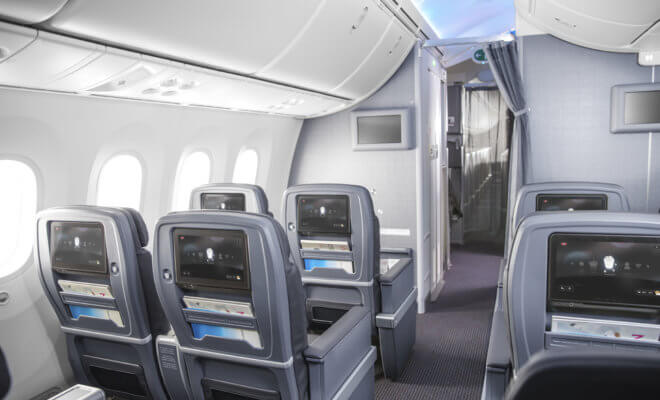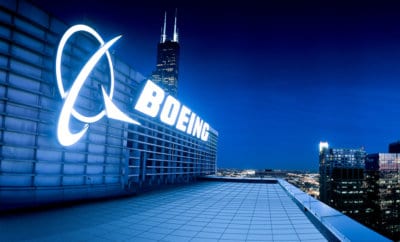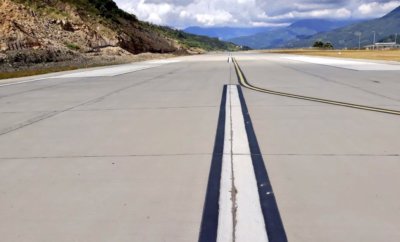Business
Tired of Being Crammed Into an Airline Seat? You Have Options

Photo : Jane L. Levere
Tired of being squeezed into smaller seats with inadequate legroom, more and more passengers are opting for the more expensive and expansive seating option known as premium economy.
This year, experts agree, will see the ongoing growth of this class of service — generally available on wide-body aircraft — most notably at United Airlines.
Although the meaning of premium economy can vary from airline to airline, typically the tickets are priced above economy class and below business class and often feature amenities such as more comfortable seats in a better location on the airplane, better dining and drinking and a more generous checked baggage allowance than economy class.
Airlines based in the United States have been the slowest to catch up to the trend, which has long been offered by competitors based in other countries.
American Airlines was the first carrier in the United States to offer premium economy service, introducing it in late 2016; Delta Air Lines did the same the following fall. United is the last of the three to follow suit, and is expected to roll out its premium economy product on select routes this year.
These carriers have been late to the game in part because of financial constraints that prevented investment in a premium economy product, according to Jamie Baker, a New York-based airline analyst for J.P. Morgan Securities. The mergers of American with US Airways and United with Continental also took a large amount of attention, he said.
One advantage U.S. carriers have by being late with their offerings is that they can learn from the longer-standing premium economy experience of their partners in other countries — such as Delta’s ties with Air France, KLM and Virgin Atlantic, and American’s with British Airways.
Henry Harteveldt, a travel industry analyst and president of Atmosphere Research Group, said it was vital that all partner airlines’ products eventually were harmonized, so that passengers flying to the United States in British Airways’ World Traveller Plus class, for example, received similar service on their flight back to the United Kingdom in American’s premium economy class.
Peter Harbison, executive chairman of CAPA-Centre for Aviation, a research consulting company based in Sydney, suggested in the organization’s daily newsletter this month that “airlines can be cavalier in describing their product as ‘premium economy.’ Depending on the airline, there’s a range of descriptions and inclusions,” with the “genuine” premium economy featuring “distinctly separate cabin, seats and service.”
But the premium economy product can sometimes be relatively bare bones. KLM’s “Economy Comfort” service, introduced in 2009, features a seat with more legroom and reclining space, and a 9-inch in-flight entertainment screen, smaller than some other carriers’, for example. Or it can be quite elaborate, such as that of Virgin Atlantic. The British carrier offered two earlier versions of its current “Premium” class of service, the first introduced in 1992 and the second in 1994.
Today’s product features dedicated check-in and baggage drop-off facilities; free check-in for two pieces of baggage; priority boarding; leather seats with up to a 38-inch pitch, footrest and headrest; an amenity kit on some flights; choice of three meals, including a vegetarian option; unlimited snacks and drinks in-flight; and a “social snack space” on 787 aircraft where passengers can gather.
Carriers competing in certain markets offer other amenities to premium economy passengers: Japanese airline JAL provides airport lounge access, while ANA does at certain airports, including at its upcoming new lounges at Daniel K. Inouye International Airport in Honolulu, where it will begin flying A380 aircraft nonstop from Tokyo next spring.
Low-cost new entrant Norwegian Air offers its premium travelers access to lounges at Gatwick Airport in London, Charles de Gaulle Airport in Paris, Kennedy International Airport in New York, Newark Liberty International Airport in New Jersey, Los Angeles International Airport and Oakland International Airport in California.
Air New Zealand, Qantas and Norwegian Air offer yet another type of benefit to premium economy passengers: All let them bid for tickets, though payment methods differ by carrier.
According to an analysis by Harteveldt of different classes of fares, for travel in September, from JFK, Miami International Airport and Los Angeles International Airport to various overseas cities, premium economy fares were generally, on average, 76 percent more expensive than standard economy fares. However, he found some relatively reasonable premium economy fares, such as a $1,253 round-trip fare between JFK and Heathrow Airport near London.
His analysis also found that “the gap between premium economy and business class was generally far greater than that between the two economy class services. However, a round-trip business-class ticket from JFK to Charles de Gaulle Airport in Paris was actually far less expensive than premium economy.”
Premium economy service gives carriers “an opportunity to create a product for passengers who are ready and willing to pay for it, generating more revenue and profit for them,” Harteveldt said. One danger it could pose, however, is the possibility of business-class passengers downgrading to premium economy, thus robbing airlines of lucrative business-class revenues.
So far this downgrading does not appear to be happening, Baker said. “We believe there is significantly more buying up from economy class than buying down from business class. It’s likely to be an area where airlines will experiment to get the right balance between the two products,” he said.
Similarly, a report released last month, by Carlson Wagonlit Travel, a travel management company, and Travelport, a travel commerce platform, on air travel originating in Singapore from 2015 through 2017 found that “the increase in premium economy bookings seems to have come largely at the expense of economy class, and not business class.”
Greeley Koch, executive director of the Association of Corporate Travel Executives, a trade group for corporate travel managers, believes “one size does not fit all” business travelers. He finds some business travelers flying to Europe from the United States still opt to buy a business-class ticket eastbound, so they can sleep on their flight, shower upon arrival and “hit the ground running.” However, on their return flight, he finds they often choose to fly in the premium economy cabin, which he said “can take the cost of a $6,000 or $7,000 ticket down to $4,000.”
Premium economy passengers are not necessarily business travelers, however. Air New Zealand estimates that 75 percent of its premium economy passengers are leisure travelers, while American Airlines says its premium economy passengers are primarily leisure travelers who previously flew in economy class. Thomas Cook Airlines finds its premium economy service is more popular with leisure travelers than business travelers, particularly those over the age of 45.
Looking ahead, Baker sees American, Delta and United continuing to improve their premium economy service. Other carriers are expected to roll out new services, such as Emirates, which plans to launch its premium economy product on A380 aircraft slated to be delivered in about 2020. Other airlines also are expected to continuously upgrade their product. Qantas, which introduced a new premium economy seat on its 787-9 aircraft late last year, is speaking with airplane seat manufacturers and its frequent flyers about new premium economy seating in the next generation of its ultra-long-haul aircraft, which it hopes to fly nonstop from the east coast of Australia to both London and New York by 2022.
Richard Johnson, director, Asia Pacific, for CWT Solutions Group, the consulting division of Carlson Wagonlit Travel, said he believed the popularity of premium economy might well grow among corporate travel managers working for companies trying to woo millennial employees. “The new generation is influenced by benefits, including a corporate travel policy, when it decides who to work for. The flexibility and comfort of premium economy can be a smart way to attract and retain them,” he said.
And Helane Becker, airline analyst for Cowen and Co., said she believed that as low-cost carriers offering premium economy service — which also include WOW air and Condor — continued to expand their long-haul operations, “all airlines will have to rethink how they compete with them. One way will be to offer cheap seats, in premium economy, for business and leisure travelers to buy.”
Premium economy could also appeal to millennial leisure travelers and baby boomers, as well as to travelers from rapidly growing markets such as China, Brazil and India, she said, adding, “It’s about airlines trying to figure out a way to shift the mix, from fewer, low-yield passengers to more high-yielding passengers.”
© 2018 New York Times News Service




You must be logged in to post a comment Login